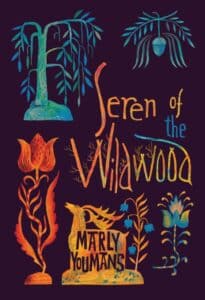Marly Youmans has written a marvelous epic story
It begins with a cross word. A father, exasperated by his two young sons, wishes out loud that he had had a daughter instead. What he doesn’t know is that the wildwood, near where the family lives, is listening. Or someone on the wildwood is listening. And the father’s words are about to be accommodated.
The two boys die in the woods; the parents mourn. The mother eventually has another child, a girl, whom they name Seren. The wildwood watches her grow up. She begins to hear its almost-siren-like call. One day, she hears its voice, which she names Aidan. And she follows that voice into the woods, beginning a journey marked by terror, violence, kindness, love, affection, learning — all of the things that make up life.
Seren of the Wildwood is an epic poem by poet, novelist, and short story writer Marly Youmans. Each of its 61 “chapters” is composed of 21 lines of 10 syllables each (iambic pentameter), followed by a shorter, five-line rhyming poem. After an introductory poem, this is how the story of Seren begins:

The needfulness that might have saved their lives
From harm was torn in two, and afterward
They were dismayed, bewildered by surprise.
The father looked as handsome as a dream
Of elvishness, a man whose element
Seemed fire, his aura crackling energy,
His potent green-eyed glance a stream of sparks;
The mother softer, secretive, bue-eyed,
Her element not fire but water: force
That mines the roots of mountains, flies to clouds …
Was he too proud a flame, too rich in youth?
Did she demand too much in quietness?
Or did their beauty lure the wildwood’s stare?
Of course, he was the one to speak the words,
Sudden, wrathful, turning on the children,
Two little boys who leaped in reckless joy
And never thought of punishment and doom.
“I wish I had a daughter, not you boys
Who shut your ears and are no help to me!”
The edge of things is always dangerous,
And trees
May shelter eyes and ears
That do not care to please—
The shade where something hears,
The dark where something sees.
The reader is struck by two things almost immediately. First, the sheer imagination of this work is marvelous. It’s an engaging, enthralling story, part epic, part fairy tale, part Iliad and part Odyssey. It’s the story of a girl who, through no fault of her own, finds herself an actor in an unexpected drama.
The second striking thing is the discipline that’s required to write a work like this. You don’t write 61 poems of 21 ten-syllable lines each followed by a five-line rhyming coda without determination, focus, the self-confidence that you’ll finish it, and even courage to undertake it in the first place.
Simply put, Seren of the Wildwood dazzles while it provokes fundamental questions. Is life simply what’s fated for us, or are we free agents? How do we deal with guilt? How do we accept the responsibilities thrust upon us? How do we live during this perilous journey called life?

Marly Youmans
Youmans received degrees from Hollins College, Brown University, and the University of North Carolina at Chapel Hill. She’s published some 16 works, including poetry collections, novels, and fantasies for young readers. She’s received numerous awards and recognitions for her writing, including the Michael Shaara Award for Excellence in Civil War Fiction (for The Wolf Pit). She lives with her family in Cooperstown, New York, and she blogs at The Palace at 2 a.m.
The work is illustrated by Clive Hicks-Jenkins, a Welsh artist/illustrator who’s worked with Youmans on all but one of her book covers. He’s illustrated several books for Simon Armitage, the current British Poet Laureate, and also the forthcoming translation of Beowulf by Seamus Heaney for the Folio Society.
Seren of the Wildwood is one of the most imaginative works I’ve read, and especially in poetry. It’s the kind of work that you know is changing you as you read it, and you emerge from it as not quite the same person you were before. It’s not unlike what happens to Seren on her journey through the wildwood.
Photo by zolakoma, Creative Commons, via Flickr. Post by Glynn Young.
How to Read a Poem uses images like the mouse, the hive, the switch (from the Billy Collins poem)—to guide readers into new ways of understanding poems. Anthology included.
“I require all our incoming poetry students—in the MFA I direct—to buy and read this book.”
—Jeanetta Calhoun Mish
- Poets and Poems: Sandra Marchetti and “Diorama” - April 24, 2025
- Poets and Poems: Christina Cook and “Roaming the Labyrinth” - April 22, 2025
- Longfellow’s “Paul Revere’s Ride”: Creating a National Legend - April 17, 2025


L.L. Barkat says
LOVE that book cover!!! 🙂